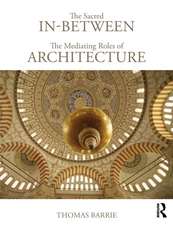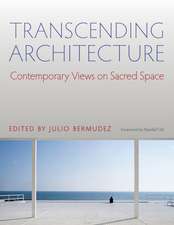Architecture, Culture, and Spirituality
Autor Thomas Barrie, Julio Bermudez, Phillip James Tabben Limba Engleză Hardback – 28 oct 2015
| Toate formatele și edițiile | Preț | Express |
|---|---|---|
| Paperback (1) | 325.36 lei 6-8 săpt. | |
| Taylor & Francis – 7 iun 2017 | 325.36 lei 6-8 săpt. | |
| Hardback (1) | 770.74 lei 6-8 săpt. | |
| Taylor & Francis – 28 oct 2015 | 770.74 lei 6-8 săpt. |
Preț: 770.74 lei
Preț vechi: 1106.63 lei
-30% Nou
Puncte Express: 1156
Preț estimativ în valută:
147.50€ • 153.42$ • 121.77£
147.50€ • 153.42$ • 121.77£
Carte tipărită la comandă
Livrare economică 12-26 aprilie
Preluare comenzi: 021 569.72.76
Specificații
ISBN-13: 9781472441713
ISBN-10: 1472441710
Pagini: 272
Ilustrații: Includes 87 b&w illustrations
Dimensiuni: 174 x 246 x 20 mm
Greutate: 0.82 kg
Ediția:New ed
Editura: Taylor & Francis
Colecția Routledge
Locul publicării:Oxford, United Kingdom
ISBN-10: 1472441710
Pagini: 272
Ilustrații: Includes 87 b&w illustrations
Dimensiuni: 174 x 246 x 20 mm
Greutate: 0.82 kg
Ediția:New ed
Editura: Taylor & Francis
Colecția Routledge
Locul publicării:Oxford, United Kingdom
Notă biografică
Thomas Barrie AIA is a Professor of Architecture at North Carolina State University. His research focuses on alternative histories of architecture and, in particular, the interrelationship of a culture’s architecture, its cultural/religious beliefs and its socio-political, doctrinal and ritual agendas. His research has brought him to sacred sites around the world and he has published numerous articles and lectured extensively on his subject area. He is the author of The Sacred In-Between: The Mediating Roles of Architecture (Routledge, 2010) and Spiritual Path, Sacred Place: Myth Ritual and Meaning in Architecture (Shambhala, 1996). Julio Bermudez is an Associate Professor at the Catholic University of America School of Architecture and Planning where he directs the Sacred Space and Cultural Studies graduate concentration. He holds a Master of Architecture and a Ph.D. in Education degrees from the University of Minnesota. His expertise covers architectural phenomenology and the relationship between architecture, culture and spirituality. Bermudez has widely lectured, led symposia, and published in these areas. His current research includes a fMRI study of architecturally induced contemplative states and a large survey on profound experiences of place. His book Transcending Architecture published by CUA Press was released in Winter 2015. He co-founded the Forum for Architecture, Culture and Spirituality in 2007. Bermudez has received many recognitions including the 1998 AIA Education Honors Award, the 2004-05 ACSA Creative Achievement Award, the 2005 Premio Trayectoria Creativa Arturo Montagu (by SIGraDI, Latin America), and the 2010 Sasada Award (by CAADRIA, Asia). Phillip Tabb is Professor of Architecture at Texas A&M University where he is the holder of the Liz and Nelson Mitchell Professor of Residential Design. He served as Head of the Department from 2001-2005, and was Director of the School of Architecture and Construction Management at Washington St
Recenzii
’Why a book about spirituality for architecture readers that does not focus primarily on religious buildings? The thesis presented here is provocative: spirituality is a dimension of the world, not only or always of organized religions and their spatial accommodation and representation. The old sense of the spiritual or transcendent as beyond the everyday won’t work anymore. Grasping spirituality today requires attention to both organized religions and seemingly prosaic conditions: streets, some full of activity, others empty; also buildings, some marvelously complete, others in ruin; and much more. Although the book’s five parts - ontological, historical, representational, topographical, and practical - are grounded by philosophical questioning, they also address contemporary design practice. Accordingly, spirituality is not an optional concern for architects but a key to the primary task of binding the individual work to the world.’ David Leatherbarrow, University of Pennsylvania, USA
Cuprins
Chapter 1 Introduction, ThomasBarrie, JulioBermudez, Phillip JamesTabb; Part I Being in the World; Chapter 2 On Architecture, Divinity, and the Interhuman, MichaelBenedikt; Chapter 3 Encountering Significance, RandallTeal; Chapter 4 Phenomenology of the Architectural Extraordinary and Merleau-Ponty’s Philosophy, JulioBermudez; Part II Sacred, Secular, and the Contemporary Condition; Chapter 5 The Sacred becomes Profane, Michael J.Crosbie; Chapter 6 An Aesthetic and Ethical Account of Genius Loci, HyejungChang; Chapter 7 Neophilia, Spirituality, and Architecture, PaulTesar; Part III Symbolic Engagements; Chapter 8 A Home in the World, ThomasBarrie; Chapter 9 Symbolism and Myth of Mountains, Stone, and Light as Expressed in Sacred Architecture, AnatGeva; Chapter 10 Narrating Chichén Itzá, LindsayJones; Part IV Sacred Landscapes; Chapter 11 Space, Object, and Encounter, RebeccaKrinke; Chapter 12 Regarding Sacred Landscapes and the Everyday Corollary, Dennis AlanWinters; Chapter 13 Sacred Landscapes, A.T.Mann; partV Spirituality and the Designed Environment; Chapter 14 Secular Sacredness in Place Creation, Phillip JamesTabb; Chapter 15, RumikoHanda; Chapter 16 Wonder, Wisdom, and Mastery in Architecture, PremChandavarkar; Chapter 17 From Within, NaderArdalan;
Descriere
Architecture has long been understood as a cultural discipline able to articulate the human condition and lift the human spirit, yet the spirituality of architecture is rarely directly addressed in academic scholarship.The seventeen chapters provide a diverse range of perspectives, grouped according to topical themes: Being in the World; Sacred, Secular, and the Contemporary Condition; Symbolic Engagements; Sacred Landscapes; and Spirituality and the Designed Environment. Even though the authors’ approach the subject from a range of disciplines and theoretical positions, all share interests in the need to rediscover, redefine, or reclaim the sacred in everyday experience, scholarly analysis, and design.










